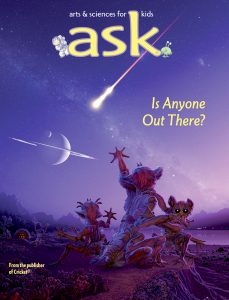Look! Up in the sky! It’s a bird! (No.) It’s a plane! (No.) It’s a planet? (Possibly…let’s find out.)
Asteroids, super moons, eclipses, and satellites have all been in the news lately and this may have prompted your junior astronomer to make statements like the ones above. If you are a layperson when it comes to astronomy, the difference between a planet and a star, a constellation and a star cluster, Venus and Mars may be as unclear as the difference between a crocodile and alligator or a stalagmite and a stalactite: there is a difference for sure, but it sure isn’t obvious.
Discover the Wonder of Astronomy
Luckily, there are resources out there to help you help your child discover the wonder of astronomy. Here are a few simple ways to make stargazing even more enjoyable for everyone in your family:
Google Sky is a free app available for both Android and iPhone users that turns your phone or iPad into your own personal planetarium. Just download the app, point your mobile phone at the sky, and Sky Map will name everything in the vicinity. You’ll see planets, stars, constellations…you name it. No more guessing if those three stars in a row are part of the Big Dipper; now you’ll know for sure.
NASA.gov should be your go-to source for information on satellites, rocket launches, meteor showers, and new discoveries from the very edges of space. Plus, NASA has amazing photos and lots of info made especially for kids, including a NASA Kids’ Club with activities and games for kids of all ages.
Discovery Kids has a library of videos answering questions such as “Is the sun actually yellow?” and “What Happens Inside a Black Hole?” You know, the kinds of things kids actually ask and we parents have no ideas about.
 Astronomy magazines for kids are a great way to get up-to-date information delivered straight to your mailbox. Unlike books, which can easily be made obsolete by new discoveries, monthly magazines are better able to update their content, giving young readers timely and relevant information about upcoming celestial events. For example, look for upcoming issues of DIG INTO HISTORY, CLICK, and ASK from the Cricket Media family of magazines related to the first total solar eclipse that passes part of the the US (Hawaii) in 26 years and the first to go coast-to-coast in 99 years. Subscribe now to make sure you get these informative issues.
Astronomy magazines for kids are a great way to get up-to-date information delivered straight to your mailbox. Unlike books, which can easily be made obsolete by new discoveries, monthly magazines are better able to update their content, giving young readers timely and relevant information about upcoming celestial events. For example, look for upcoming issues of DIG INTO HISTORY, CLICK, and ASK from the Cricket Media family of magazines related to the first total solar eclipse that passes part of the the US (Hawaii) in 26 years and the first to go coast-to-coast in 99 years. Subscribe now to make sure you get these informative issues.
The real lesson here is that it doesn’t matter whether you have your own telescope or not, whether you live in a place dark enough to see the Milky Way or a place with so much light pollution that it is hard to make out the moon, whether there is a planetarium around the corner or across the state, today’s technology makes educating future scientists about the wonders of space easy and accessible, leaving even more time for your whole family to just contemplate exactly what might be out there.



